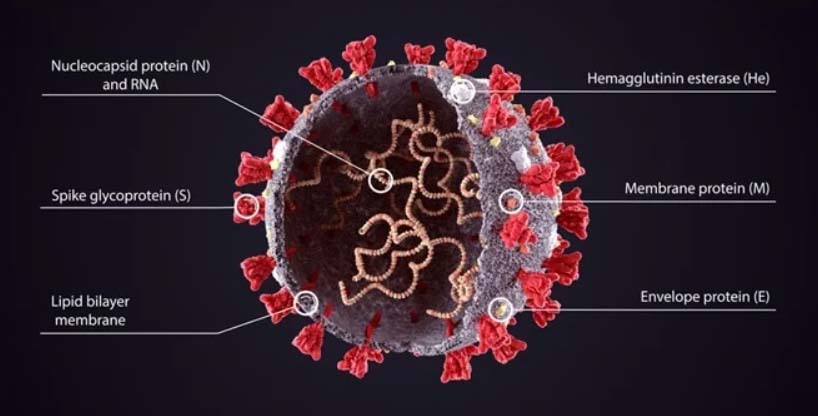5 Things You Need to Know About Spike Protein

The COVID-19 pandemic has brought a lot of attention to the spike protein of the SARS-CoV-2 virus, and for good reason. This small structure on the virus’ surface plays a crucial role in its ability to enter human cells, and its variability through mutations has made it a moving target for treatment development.
But that's not all - recent research has shed light on the potential long-term effects of the spike protein, including its ability to cross the blood-brain barrier and impact cognitive function. In this article, we'll outline five quick-fire facts about the COVID-19 spike protein that you may not have heard before.
1) The spike protein allows the virus to enter human cells
The spike protein is a structure on the surface of the SARS-CoV-2 virus that allows it to enter human cells. The spike protein binds to a receptor called ACE2, which is present on the surface of many human cells, particularly those in the lungs [1]. The spike is integral to the processes of cell recognition, attachment, and viral fusion during infection. Once the virus has fused to ACE2, it can enter the cell and replicate, leading to the spread of the virus throughout the body.
2) The spike protein is the most variable part of the virus
While the SARS-CoV-2 virus as a whole is relatively stable, the spike protein is the most variable part of the virus. This means that the spike protein can change rapidly through mutations, which can make it more or less effective at binding to ACE2 receptors on human cells [2]. It is also why the development of new COVID-19 vaccines and treatments is an ongoing process.
3) The spike protein has implications for long-term COVID-19 symptoms
Recent research has suggested that the spike protein of the SARS-CoV-2 virus may play a role in some of the long-term symptoms experienced by COVID-19 patients, such as fatigue, brain fog, and shortness of breath. Research has shown that it can last in the body for up to 12 months post-infection [3].
4) The spike protein can cross the blood-brain barrier
The blood-brain barrier (BBB) is a highly selective semipermeable membrane barrier that separates the circulating blood from the brain and extracellular fluid in the central nervous system (CNS). Its primary function is to protect the brain from potentially harmful substances, such as toxins and pathogens, while allowing essential nutrients and gases to pass through.
A study performed in 2021 demonstrates the mechanisms by which the Spike protein can disrupt the blood-brain-barrier, potentially harmful brain cells and impacting cognitive function [4].
5) The spike protein can be degraded by natural compounds
Research has shown that spike protein can be broken down by multiple natural compounds, most notably Nattokinase. Another natural compound, dandelion root extract, has been shown to block the protein from binding to ACE2 receptors. Both of these potent therapeutics are included in The Wellness Company’s Spike Support Formula [5].
References
[1] Hatmal, M. M. M., Alshaer, W., Al-Hatamleh, M. A., Hatmal, M., Smadi, O., Taha, M. O., ... & Plebanski, M. (2020). Comprehensive structural and molecular comparison of spike proteins of SARS-CoV-2, SARS-CoV and MERS-CoV, and their interactions with ACE2. Cells, 9(12), 2638.
[2] Gupta, D., Sharma, P., Singh, M., Kumar, M., Ethayathulla, A. S., & Kaur, P. (2021). Structural and functional insights into the spike protein mutations of emerging SARS-CoV-2 variants. Cellular and Molecular Life Sciences, 1-23.
[3] Swank, Z., Senussi, Y., Manickas-Hill, Z., Yu, X. G., Li, J. Z., Alter, G., & Walt, D. R. (2023). Persistent circulating severe acute respiratory syndrome coronavirus 2 spike is associated with post-acute coronavirus disease 2019 sequelae. Clinical Infectious Diseases, 76(3), e487-e490.
[4] DeOre, B. J., Tran, K. A., Andrews, A. M., Ramirez, S. H., & Galie, P. A. (2021). SARS-CoV-2 spike protein disrupts blood–brain barrier integrity via RhoA activation. Journal of Neuroimmune Pharmacology, 16, 722-728.
[5] Tran, H. T. T., Gigl, M., Le, N. P. K., Dawid, C., & Lamy, E. (2021). In vitro effect of Taraxacum officinale leaf aqueous extract on the interaction between ACE2 cell surface receptor and SARS-CoV-2 spike protein D614 and four mutants. Pharmaceuticals, 14(10), 1055.






















